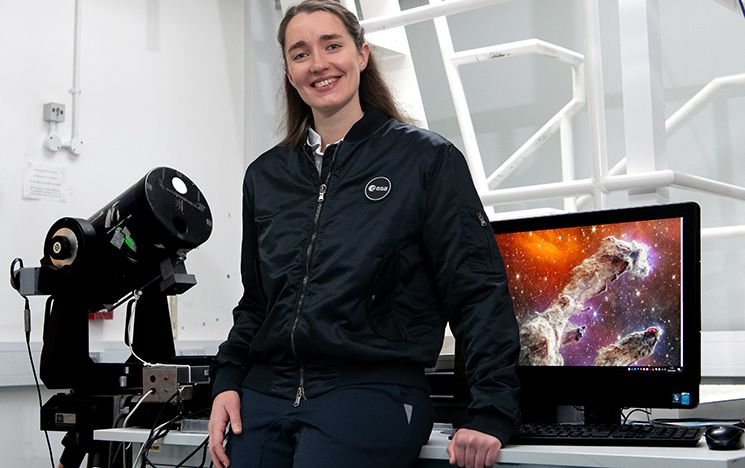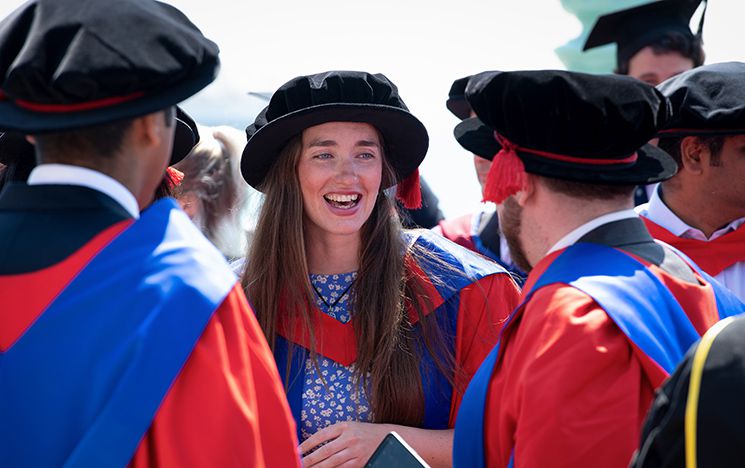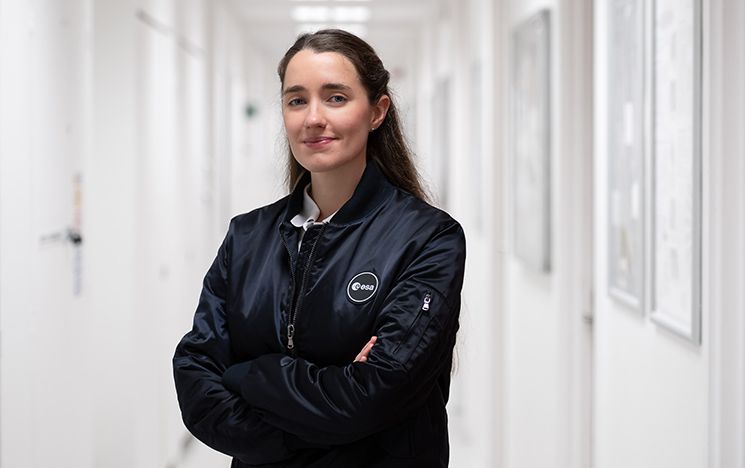Fly me to the moon
One small step for the UK, one giant leap for Dr Rosemary Coogan (Astrophysics 2015), who was recruited to be the European Space Agency’s first female UK astronaut in November 2022.
Dr Rosemary Coogan, the first female UK astronaut for the European Space Agency (ESA), has fond childhood memories of the University of Sussex.
From the age of four months to five-years-old she lived in East Slope while her parents studied at the University. Twenty years later she returned to undertake a doctorate in astrophysics.
“As a child I remember it being this really interesting, multicultural environment,”she says. “And because Sussex was familiar to me (and the Astronomy Department is fantastic), I came back to do my PhD.”
Rosemary, 32, returned to campus again in 2023 before starting her intensive astronaut training in Cologne, Germany. She revisited the labs and offices where she had carried out research on how galaxy formation is affected by the surrounding environment.
She also caught up with former colleagues, including her PhD examiner Dr Stephen Wilkins (now Head of the Astronomy Centre), and Professor Kathy Romer, who was her pastoral care tutor during her studies. They are thrilled with Rosemary’s stellar new job, which was announced by ESA in November 2022.
“We knew she had applied, but you never dare assume it’s going to work out,” says Kathy.“It sends out a huge message, not just to our students, but to every girl in primary school who will think, ‘that could be me!’”
Personable, curious and clearly very smart, Rosemary is also surprisingly modest about why she thinks she made it to the final five out of more than 22,000 applicants to become one of ESA’s career astronauts.
“I had been keeping an eye on when ESA might be recruiting again – the last time was in 2008. I think I was lucky that I was about the right age and that I matched the profile of what they were looking for.”

As a career astronaut, she will be trained to take part in space flights, space walks and could one day be taking her first steps on the Moon. The space agency also recruited 11 reserve astronauts, who will be given opportunities for special projects, and the UK’s John McFall, who, as an amputee, was selected to become ESA’s first parastronaut.
The selection process involved assessing Rosemary’s physical fitness for endurance in challenging conditions, her cognitive speed and analytical skills, and psychometric tests to see how she copes under pressure.
“We did a lot of work with psychologists,”she says. “We had group exercises where they looked for balance between group leadership and being able to support the leader as a team member. It seems an essential strength is the ability to stay calm.”
I’m also interested in ESA’s other activities – from observations via their satellites for monitoring effects of climate change, to studying what happens to the human body in space and how it affects ageing.”
Depending on what is required of her, Rosemary may join projects on board the International Space Station (ISS) or be part of ESA’s human flight missions to the Moon and to Gateway, an orbiting space station that will be a staging post for missions to the Moon. These are expected to take place by the late 2020s and will look at how feasible it is to build a base there.
“I have always been fascinated by space, but I wanted to contribute more to ESA’s efforts in terms of exploring our local solar system,” says Rosemary. “I’m also interested in ESA’s other activities – from observations via their satellites for monitoring rising sea levels and other effects of climate change, to studying what happens to the human body in space and how it affects ageing.”
The next stage for Rosemary is a 12-month intensive training schedule. It begins with classroom-based activities, such as learning about space law and how it applies to exploration, as well as looking at different systems on board the ISS and aspects of astrophysics, for which she is well prepared.
The recruits will then move to physical activities, including underwater training in a space suit with full-size replicas of the space station.“This is the closest we can get on Earth to learning what it’s like to manoeuvre in a weightless environment,” she says. “It requires us to have a SCUBA diving licence, which I already happen to have having been a member of the SCUBA Diving Society at Sussex!”
We did a lot of work with psychologists…where they looked for balance between group leadership and being able to support the leader as a team member. It seems an essential strength is the ability to stay calm.”
In fact, Rosemary is happy to confirm that Sussex has played a major role in shaping the direction of her life – from her early years happily playing with her international pals at the University’s nursery, to her experience of studying at Sussex after taking her undergraduate and Masters degrees in physics and astronomy at the University of Durham.
“I found the learning environment at Sussex wonderful,” she says. “I like that the Astronomy Department’s research is extra-galactic, and I like the breadth. There were so many people studying the things that I was interested in, but also things that were quite different.
“It’s an open place in which to learn, and I felt like I was given a lot of options. I wasn’t channelled in one direction.
“It’s also a supportive environment, especially for all genders in science. As a PhD student, I was in an office of three women and two men, and I thought there was a good representation of gender among the staff too.”
Although she completed her PhD in 2019, Covid restrictions meant that Rosemary had to wait until 2022 to attend Sussex’s mammoth summer graduation celebration, which she finished in style with fellow graduates and members of the Astronomy Department by having an intergalactic battle at LaserZone in Brighton.
When she received the exciting news last November that she was about to become an astronaut, she was working near Paris for the French space agency CNES at CEA-Saclay, analysing data from the early Universe via the James Webb Space Telescope.
That said, having a passion for astrophysics isn’t essential for an astronaut. Rosemary points out that her fellow recruits have come from a range of occupations, such as engineering, aviation, medicine and neuroscience. But she acknowledges that her outside interests, which included training as a petty officer cadet with the Royal Navy Sea Cadets in Brighton and being promoted to Midshipman of the Royal Naval Reserve, show she is suited to and performs well in highly structured environments.
She anticipates that when she is finally on her first mission, any anxiety over which controls to operate in the space capsule is likely to have been ironed out. “We will have rehearsed the procedures so many times that I’m sure it will become second nature.”
During the months she is away, she expects she may miss her family and friends, and some of the simple pleasures of life on Earth, such as making toast and having a shower (both impossibilities in space).
“I’ll be able to take a small box of personal treasures with me,” she adds. “I really enjoy fantasy adventure board games, and I would love to work out whether it’s possible to roll a die in space, though I’m sure the excitement and privilege of being on a mission will far outweigh missing any creature comforts.”
[Rosemary’s appointment] sends out a huge message, not just to our students, but to every girl in primary school who will think, ‘that could be me!’ ” KATHY ROMER
Professor of Astrophysics, School of Mathematical and Physical Sciences

